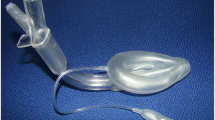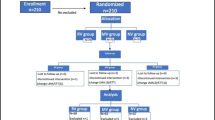Abstract
We compared the intracuff pressure (ICP) of a laryngeal mask airway (LMA) in the lateral and prone positions with that in the supine position. One hundred and eight patients, weighing 50–70 kg, scheduled for elective orthopedic and plastic surgery, were assigned to three groups, based on their body position during surgery. General anesthesia was induced and then a size 4 deflated LMA was inserted in each patient in the supine (group 1; n = 42), lateral (group 2; n = 45), or prone position (group 3; n = 21). The LMA cuff was inflated with 15 ml of air. Anesthesia was maintained without nitrous oxide, and the ICP was measured until LMA removal in the supine position. ICP in groups 2 and 3 was significantly lower than that in group 1 from immediately after insertion to the end of surgery. After surgery, turning from the lateral (group 2) or prone (group 3) position to the supine position significantly raised the ICP. Because the ICP is related to the seal pressure of the LMA and postoperative pharyngolaryngeal morbidity, we recommend evaluating and adjusting the ICP appropriately in each body position.
Similar content being viewed by others
References
Verghese C, Smith TG, Young E. Prospective survey of the use of the laryngeal mask airway in 2359 patients. Anaesthesia. 1993;48:58–60.
Chen CH, Lin CC, Tan PP. Clinical experience of laryngeal mask airway in lateral position during anesthesia (in Chinese with English abstract). Acta Anaesthesiol Sin. 1995;33:31–34.
Dimitriou V, Voyagis GS, Iatrou C, Brimacombe J. Flexible lightwand-guided intubation using the intubating laryngeal mask airway in the supine, right, and left lateral positions in healthy patients by experienced users. Anesth Analg. 2003;96:896–898.
Ng A, Raitt DG, Smith G. Induction of anesthesia and insertion of a laryngeal mask airway in the prone position for minor surgery. Anesth Analg. 2002;94:1194–1198.
Brimacombe JR, Wenzel V, Keller C. The proseal laryngeal mask airway in prone patients: a retrospective audit of 245 patients. Anaesth Intensive Care. 2007;35:222–225.
Ono T, Otsuka R, Kuroda T, Honda E, Sasaki T. Effects of head and body position on two-and three-dimensional configurations of the upper airway. J Dent Res. 2000;79:1879–1884.
Litman RS, Wake N, Chan LM, McDonough JM, Sin S, Mahboubi S, Arens R. Effect of lateral positioning on upper airway size and morphology in sedated children. Anesthesiology. 2005;103:484–488.
Pevernagie DA, Stanson AW, Sheedy PF 2nd, Daniels BK, Shepard JW Jr. Effects of body position on the upper airway of patients with obstructive sleep apnea. Am J Respir Crit Care Med. 1995;152:179–185.
Matsuzawa Y, Hayashi S, Yamaguchi S, Yoshikawa S, Okada K, Fujimoto K, Sekiguchi M. Effect of prone position on apnea severity in obstructive sleep apnea. Intern Med. 1995;34:1190–1193.
Brimacombe J, Holyoake L, Keller C, Brimacombe N, Scully M, Barry J, Talbutt P, Sartain J, McMahon P. Pharyngolaryngeal, neck, and jaw discomfort after anesthesia with the face mask and laryngeal mask airway at high and low cuff volumes in males and females. Anesthesiology. 2000;93:26–31.
Brimacombe J, Holyoake L, Keller C, Barry J, Mecklem D, Blinco A, Weidmann K. Emergence characteristics and post-operative laryngopharyngeal morbidity with the laryngeal mask airway: a comparison of high versus low initial cuff volume. Anaesthesia. 2000;55:338–343.
Keller C, Puhringer F, Brimacombe JR. Influence of cuff volume on oropharyngeal leak pressure and fibreoptic position with the laryngeal mask airway. Br J Anaesth. 1998;81:186–187.
Brimacombe J. Seal with the respiratory and gastrointestinal tracts. In: Brimacombe J, editor. Laryngeal mask anesthesia: principles and practice. Philadeiphia: Saunders; 2005. p. 137–152.
Brimacombe J, Berry A. Insertion of the laryngeal mask airway—a prospective study of four techniques. Anaesth Intensive Care. 1993;21:89–92.
Lumb AB, Wrigley MW. The effect of nitrous oxide on laryngeal mask cuff pressure. In vitro and in vivo studies. Anaesthesia. 1992;47:320–323.
Brimacombe J, Keller C. Does efficacy of seal and fibreoptic view change during anaesthesia with the laryngeal mask airway: a comparison of oxygen and oxygen-nitrous oxide gas mixtures. Acta Anaesthesiol Scand. 2000;44:1258–1260.
Brimacombe J. Anatomy. In: Brimacombe J, editor. Larygeal mask anesthesia: principles and practice. 2nd ed. Philadelphia: Saunders; 2005. p. 73–104.
Keller C, Brimacombe J. Influence of neuromuscular block, mode of ventilation and respiratory cycle on pharyngeal mucosal pressures with the laryngeal mask airway. Br J Anaesth. 1999;83:480–482.
Brimacombe J, Berry A. Laryngeal mask airway cuff pressure and position during anaesthesia lasting 1 to 2 hours. Can J Anaesth. 1994;41:589–593.
Brimacombe JR. Positive pressure ventilation with the size 5 laryngeal mask. J Clin Anesth. 1997;9:113–117.
Inagawa G, Okuda K, Miwa T, Hiroki K. Higher airway seal does not imply adequate positioning of laryngeal mask airways in paediatric patients. Paediatr Anaesth. 2002;12:322–326.
Author information
Authors and Affiliations
About this article
Cite this article
Yano, T., Imaizumi, T., Uneda, C. et al. Lower intracuff pressure of laryngeal mask airway in the lateral and prone positions compared with that in the supine position. J Anesth 22, 312–316 (2008). https://doi.org/10.1007/s00540-008-0635-1
Received:
Accepted:
Published:
Issue Date:
DOI: https://doi.org/10.1007/s00540-008-0635-1




